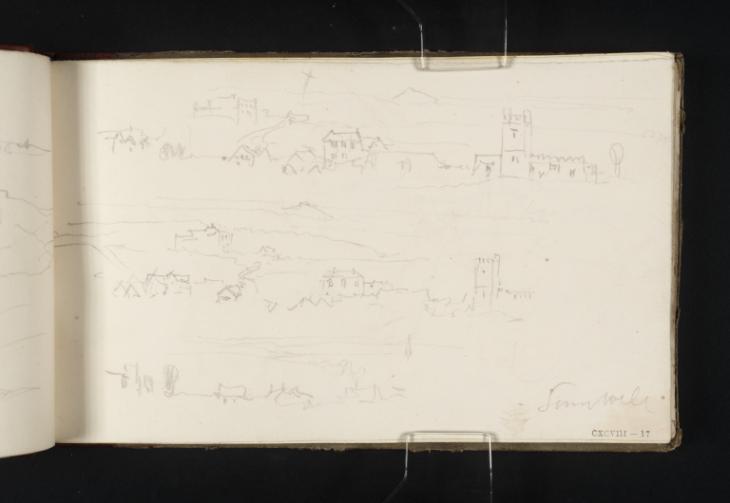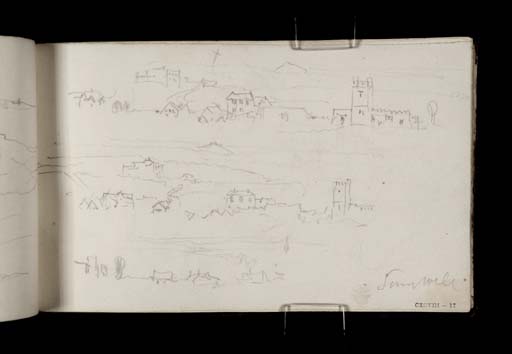Joseph Mallord William Turner Sunningwell, Oxfordshire c.1821-2
Image 1 of 2
Joseph Mallord William Turner,
Sunningwell, Oxfordshire
c.1821-2
Joseph Mallord William Turner 1775–1851
Folio 17 Recto:
Sunningwell, Oxfordshire c.1821–2
D17234
Turner Bequest CXCVIII 17
Turner Bequest CXCVIII 17
Pencil on white wove paper, 113 x 187 mm
Partial watermark ‘T Ed | 18’
Inscribed by Turner in pencil ‘[?Sunningwell]’ bottom right
Inscribed by John Ruskin in red ink ‘17’ bottom right
Stamped in black ‘CXCVIII – 17’ bottom right
Partial watermark ‘T Ed | 18’
Inscribed by Turner in pencil ‘[?Sunningwell]’ bottom right
Inscribed by John Ruskin in red ink ‘17’ bottom right
Stamped in black ‘CXCVIII – 17’ bottom right
Accepted by the nation as part of the Turner Bequest 1856
References
1909
A.J. Finberg, A Complete Inventory of the Drawings of the Turner Bequest, London 1909, vol.I, p.604, CXCVIII 17, as ‘Several sketches of “Sunningwell” (?)’.
2000
Colin Harrison, Turner’s Oxford, exhibition catalogue, Ashmolean Museum, Oxford 2000, p.86.
Two of the three sketches of Sunningwell displayed on this page are distinguished by the Oxfordshire town’s parish church, St Leonard’s. The site has played host to a church since the Middle Ages, with the present building predominantly fifteenth-century in style.1 The original tower, now replaced, is said to have acted as laboratory for the astronomical experiments of the medieval genius Friar Bacon. In the nineteenth century J.P. Seddon, associate of the Pre-Raphaelites, was involved in renovating the church. He laid unique tiles illustrating the Book of Revelation and installed stained glass in the east window.2
Turner made two more detailed studies of this church in the Oxford sketchbook of around 1789 (Tate D00024, D00026; Turner Bequest II 12, 13). See also Sunningwell Church from the North-East, produced around 1789 (Tate D00050; Turner Bequest III Ea). Turner devotes attention to the whole town on folio 2 verso of the present sketchbook (D17210).
At the bottom of the page the location recorded in a third drawing is less easily identified. A pointed spire seems to break the horizon towards the right, suggesting that Turner made this sketch outside the confines of Sunningwell, possibly closer to Oxford. Colin Harrison cites this page as part of a journey made by Turner: he begun to the west of the city on folio 2 recto (D17209) moved towards Sunningwell as displayed on the present page, and then returned to Oxford ‘to leave by the London road past Nuneham Courtenay’ (folios 87 verso and 88 recto; D17356 and D17357).3 Harrison describes this group of drawings as ‘rapid notes, and not intended for anything more than to satisfy the artist’s innate need to sketch’.4 For additional presumed or identified views of Oxford and the surrounding area in this sketchbook, see the inside front cover, and folios 1 recto and verso and 5 recto (D40685, D17207–D17208, D17214).
Maud Whatley
January 2016
‘Building and Parish’, St Leonard’s Sunningwell, accessed 4 November 2015, http://www.stleonardsunningwell.org.uk/history/building .
How to cite
Maud Whatley, ‘Sunningwell, Oxfordshire c.1821–2 by Joseph Mallord William Turner’, catalogue entry, January 2016, in David Blayney Brown (ed.), J.M.W. Turner: Sketchbooks, Drawings and Watercolours, Tate Research Publication, February 2017, https://www


